EMRM5103 Project Risk Management Plan: Construction Project
VerifiedAdded on 2023/06/13
|13
|3461
|391
Report
AI Summary
This report presents a comprehensive risk management plan developed for Turner Construction Company's project involving the construction of a research building and modernization work at an Australian University. The plan outlines the importance of risk management in ensuring project success by identifying, analyzing, and mitigating potential risks associated with construction activities. It details the risk management process, including risk management planning, identification, assessment, handling, tracking, and reporting. The report identifies specific risks related to project cost, time, testing, supplier policies, facility arrangements, design, and technology. A risk assessment matrix is provided to quantify the impact of each risk on technical aspects, schedule, and cost. The plan also includes risk probabilities and a severity matrix, along with various risk management methods such as risk avoidance and transfer, aimed at minimizing the potential consequences of adverse events and increasing the probability of project success. Desklib provides access to similar solved assignments and past papers.
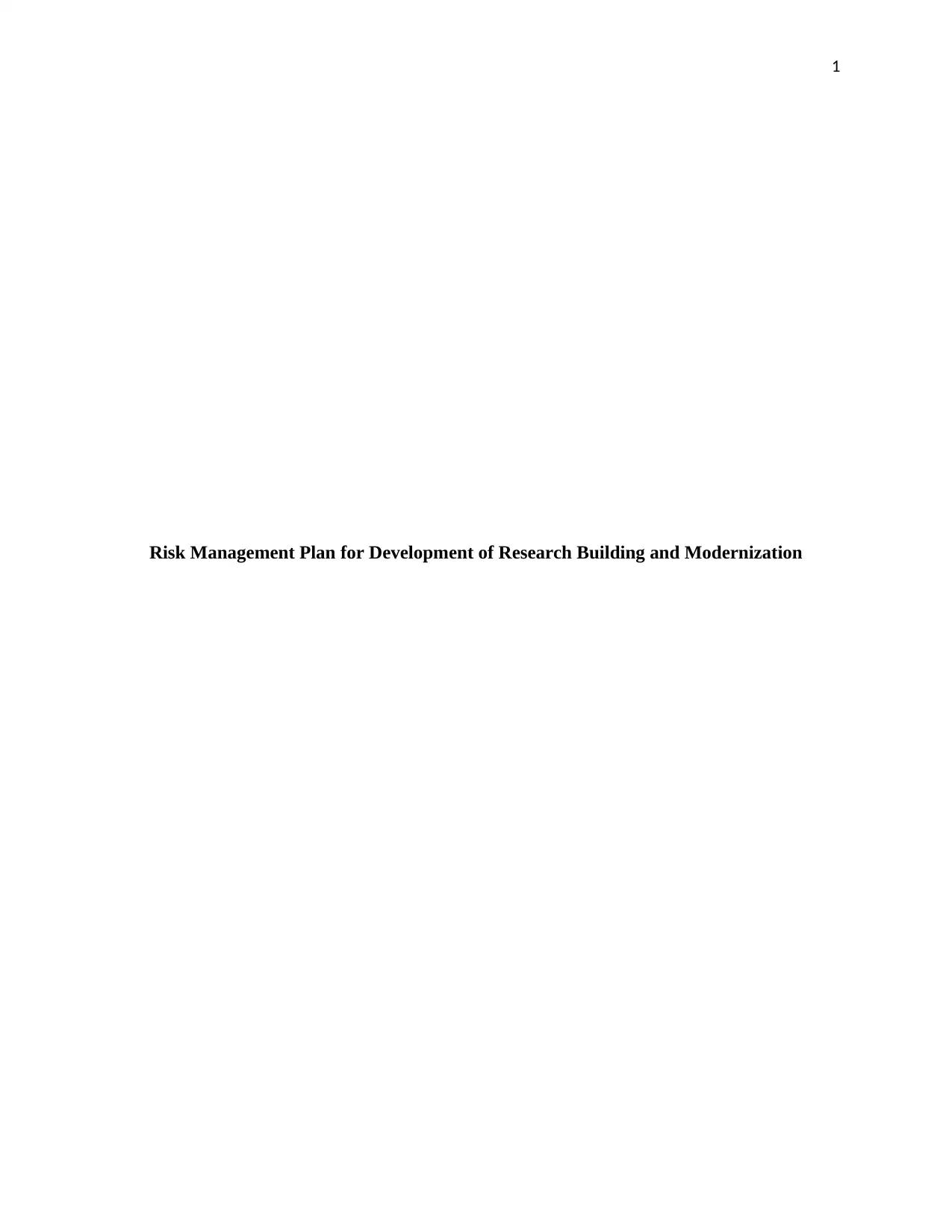
1
Risk Management Plan for Development of Research Building and Modernization
Risk Management Plan for Development of Research Building and Modernization
Paraphrase This Document
Need a fresh take? Get an instant paraphrase of this document with our AI Paraphraser
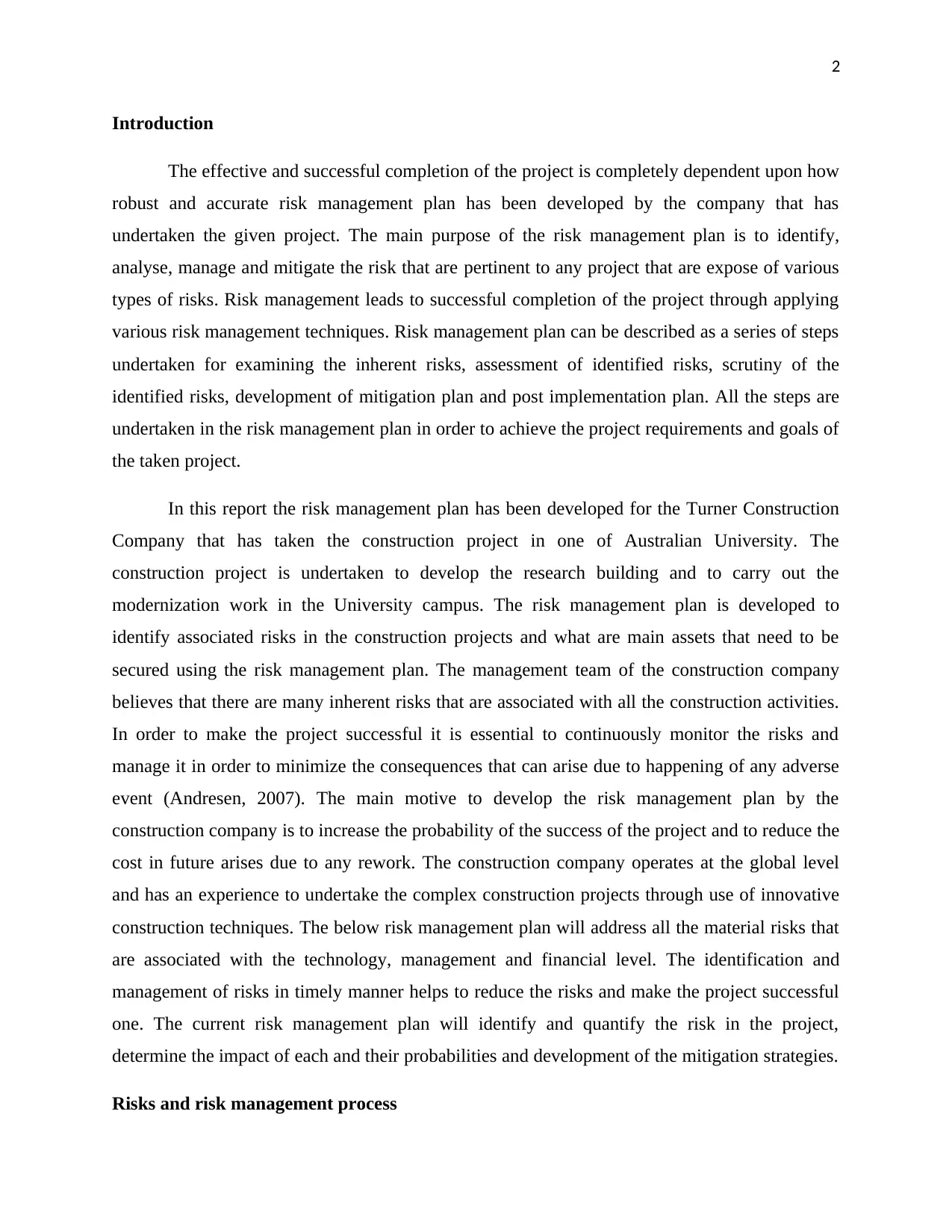
2
Introduction
The effective and successful completion of the project is completely dependent upon how
robust and accurate risk management plan has been developed by the company that has
undertaken the given project. The main purpose of the risk management plan is to identify,
analyse, manage and mitigate the risk that are pertinent to any project that are expose of various
types of risks. Risk management leads to successful completion of the project through applying
various risk management techniques. Risk management plan can be described as a series of steps
undertaken for examining the inherent risks, assessment of identified risks, scrutiny of the
identified risks, development of mitigation plan and post implementation plan. All the steps are
undertaken in the risk management plan in order to achieve the project requirements and goals of
the taken project.
In this report the risk management plan has been developed for the Turner Construction
Company that has taken the construction project in one of Australian University. The
construction project is undertaken to develop the research building and to carry out the
modernization work in the University campus. The risk management plan is developed to
identify associated risks in the construction projects and what are main assets that need to be
secured using the risk management plan. The management team of the construction company
believes that there are many inherent risks that are associated with all the construction activities.
In order to make the project successful it is essential to continuously monitor the risks and
manage it in order to minimize the consequences that can arise due to happening of any adverse
event (Andresen, 2007). The main motive to develop the risk management plan by the
construction company is to increase the probability of the success of the project and to reduce the
cost in future arises due to any rework. The construction company operates at the global level
and has an experience to undertake the complex construction projects through use of innovative
construction techniques. The below risk management plan will address all the material risks that
are associated with the technology, management and financial level. The identification and
management of risks in timely manner helps to reduce the risks and make the project successful
one. The current risk management plan will identify and quantify the risk in the project,
determine the impact of each and their probabilities and development of the mitigation strategies.
Risks and risk management process
Introduction
The effective and successful completion of the project is completely dependent upon how
robust and accurate risk management plan has been developed by the company that has
undertaken the given project. The main purpose of the risk management plan is to identify,
analyse, manage and mitigate the risk that are pertinent to any project that are expose of various
types of risks. Risk management leads to successful completion of the project through applying
various risk management techniques. Risk management plan can be described as a series of steps
undertaken for examining the inherent risks, assessment of identified risks, scrutiny of the
identified risks, development of mitigation plan and post implementation plan. All the steps are
undertaken in the risk management plan in order to achieve the project requirements and goals of
the taken project.
In this report the risk management plan has been developed for the Turner Construction
Company that has taken the construction project in one of Australian University. The
construction project is undertaken to develop the research building and to carry out the
modernization work in the University campus. The risk management plan is developed to
identify associated risks in the construction projects and what are main assets that need to be
secured using the risk management plan. The management team of the construction company
believes that there are many inherent risks that are associated with all the construction activities.
In order to make the project successful it is essential to continuously monitor the risks and
manage it in order to minimize the consequences that can arise due to happening of any adverse
event (Andresen, 2007). The main motive to develop the risk management plan by the
construction company is to increase the probability of the success of the project and to reduce the
cost in future arises due to any rework. The construction company operates at the global level
and has an experience to undertake the complex construction projects through use of innovative
construction techniques. The below risk management plan will address all the material risks that
are associated with the technology, management and financial level. The identification and
management of risks in timely manner helps to reduce the risks and make the project successful
one. The current risk management plan will identify and quantify the risk in the project,
determine the impact of each and their probabilities and development of the mitigation strategies.
Risks and risk management process
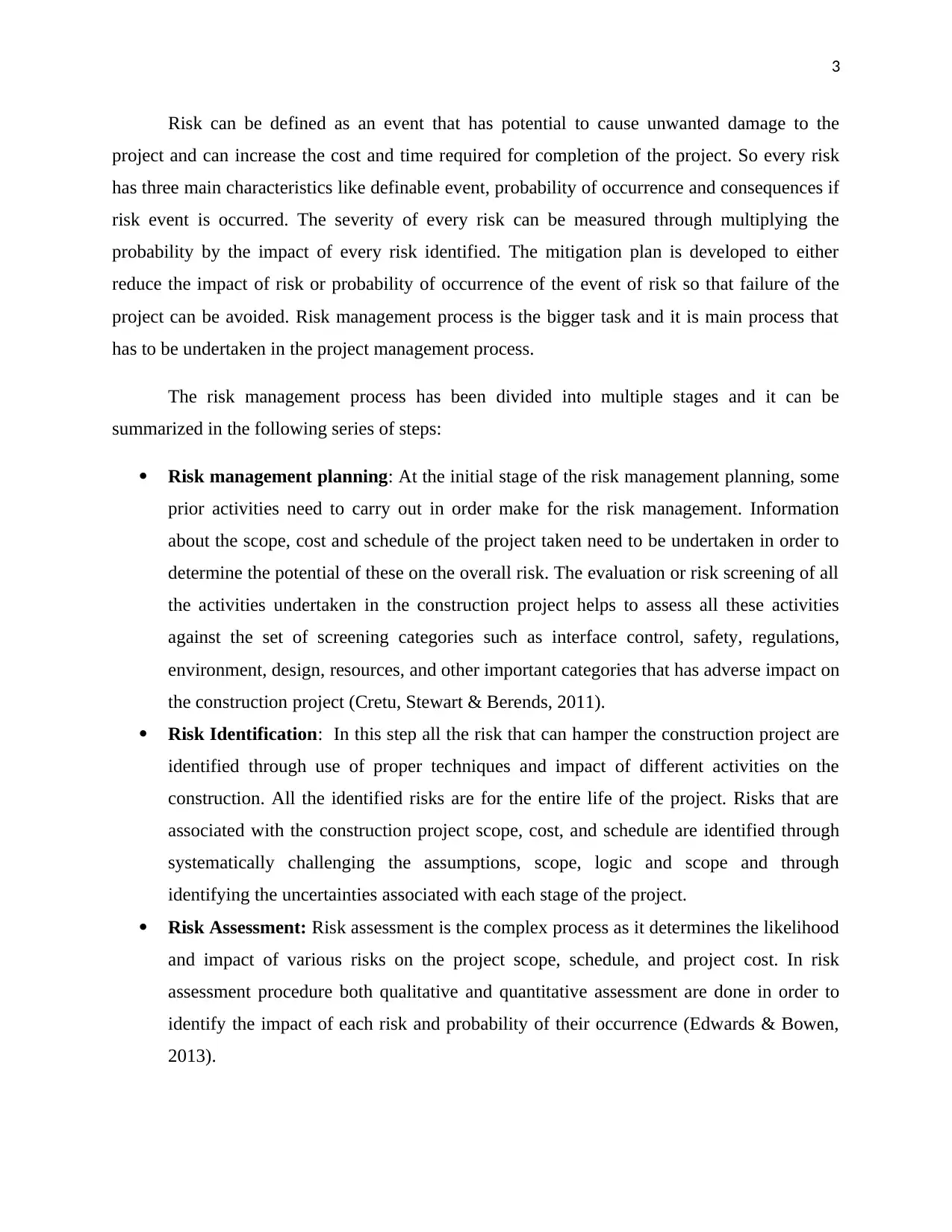
3
Risk can be defined as an event that has potential to cause unwanted damage to the
project and can increase the cost and time required for completion of the project. So every risk
has three main characteristics like definable event, probability of occurrence and consequences if
risk event is occurred. The severity of every risk can be measured through multiplying the
probability by the impact of every risk identified. The mitigation plan is developed to either
reduce the impact of risk or probability of occurrence of the event of risk so that failure of the
project can be avoided. Risk management process is the bigger task and it is main process that
has to be undertaken in the project management process.
The risk management process has been divided into multiple stages and it can be
summarized in the following series of steps:
Risk management planning: At the initial stage of the risk management planning, some
prior activities need to carry out in order make for the risk management. Information
about the scope, cost and schedule of the project taken need to be undertaken in order to
determine the potential of these on the overall risk. The evaluation or risk screening of all
the activities undertaken in the construction project helps to assess all these activities
against the set of screening categories such as interface control, safety, regulations,
environment, design, resources, and other important categories that has adverse impact on
the construction project (Cretu, Stewart & Berends, 2011).
Risk Identification: In this step all the risk that can hamper the construction project are
identified through use of proper techniques and impact of different activities on the
construction. All the identified risks are for the entire life of the project. Risks that are
associated with the construction project scope, cost, and schedule are identified through
systematically challenging the assumptions, scope, logic and scope and through
identifying the uncertainties associated with each stage of the project.
Risk Assessment: Risk assessment is the complex process as it determines the likelihood
and impact of various risks on the project scope, schedule, and project cost. In risk
assessment procedure both qualitative and quantitative assessment are done in order to
identify the impact of each risk and probability of their occurrence (Edwards & Bowen,
2013).
Risk can be defined as an event that has potential to cause unwanted damage to the
project and can increase the cost and time required for completion of the project. So every risk
has three main characteristics like definable event, probability of occurrence and consequences if
risk event is occurred. The severity of every risk can be measured through multiplying the
probability by the impact of every risk identified. The mitigation plan is developed to either
reduce the impact of risk or probability of occurrence of the event of risk so that failure of the
project can be avoided. Risk management process is the bigger task and it is main process that
has to be undertaken in the project management process.
The risk management process has been divided into multiple stages and it can be
summarized in the following series of steps:
Risk management planning: At the initial stage of the risk management planning, some
prior activities need to carry out in order make for the risk management. Information
about the scope, cost and schedule of the project taken need to be undertaken in order to
determine the potential of these on the overall risk. The evaluation or risk screening of all
the activities undertaken in the construction project helps to assess all these activities
against the set of screening categories such as interface control, safety, regulations,
environment, design, resources, and other important categories that has adverse impact on
the construction project (Cretu, Stewart & Berends, 2011).
Risk Identification: In this step all the risk that can hamper the construction project are
identified through use of proper techniques and impact of different activities on the
construction. All the identified risks are for the entire life of the project. Risks that are
associated with the construction project scope, cost, and schedule are identified through
systematically challenging the assumptions, scope, logic and scope and through
identifying the uncertainties associated with each stage of the project.
Risk Assessment: Risk assessment is the complex process as it determines the likelihood
and impact of various risks on the project scope, schedule, and project cost. In risk
assessment procedure both qualitative and quantitative assessment are done in order to
identify the impact of each risk and probability of their occurrence (Edwards & Bowen,
2013).
⊘ This is a preview!⊘
Do you want full access?
Subscribe today to unlock all pages.

Trusted by 1+ million students worldwide
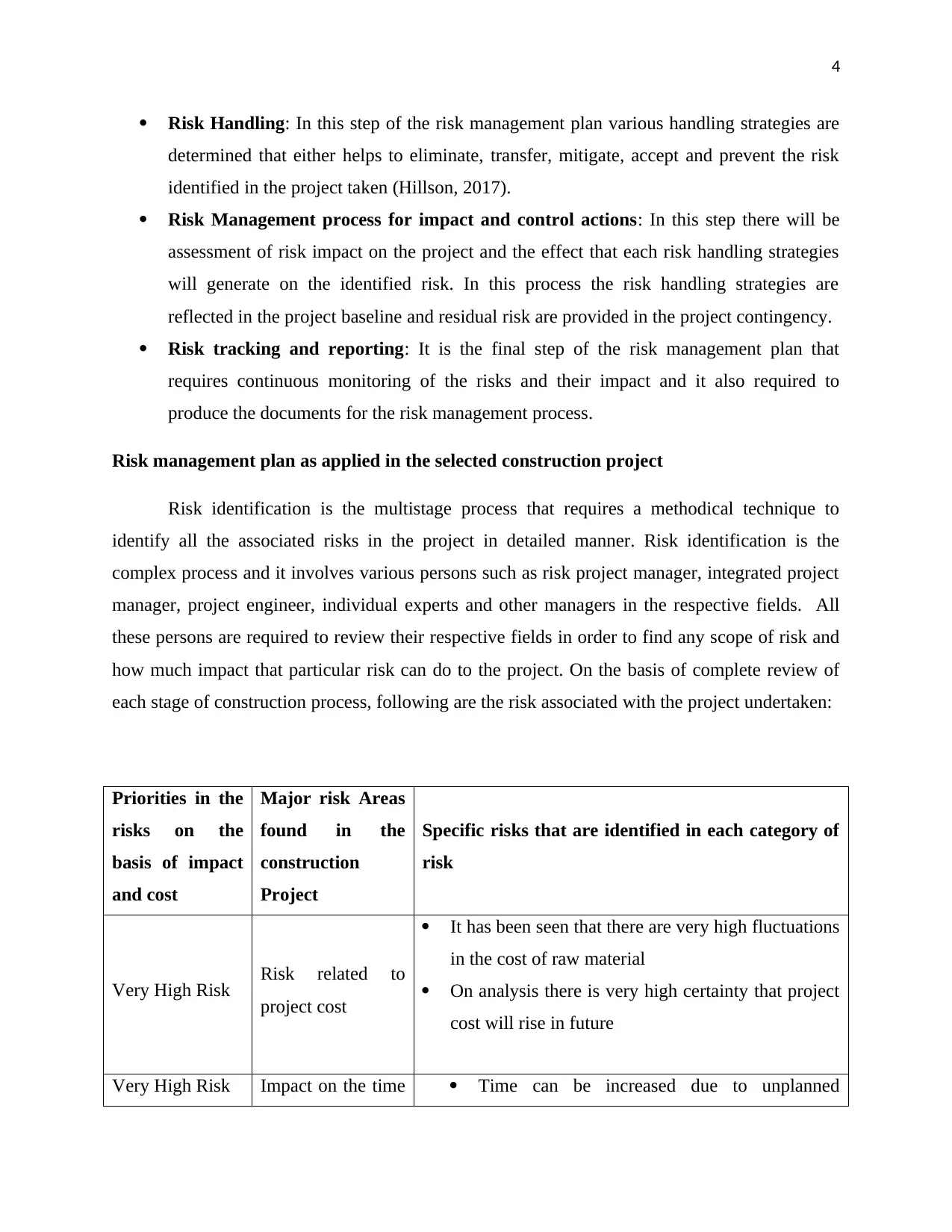
4
Risk Handling: In this step of the risk management plan various handling strategies are
determined that either helps to eliminate, transfer, mitigate, accept and prevent the risk
identified in the project taken (Hillson, 2017).
Risk Management process for impact and control actions: In this step there will be
assessment of risk impact on the project and the effect that each risk handling strategies
will generate on the identified risk. In this process the risk handling strategies are
reflected in the project baseline and residual risk are provided in the project contingency.
Risk tracking and reporting: It is the final step of the risk management plan that
requires continuous monitoring of the risks and their impact and it also required to
produce the documents for the risk management process.
Risk management plan as applied in the selected construction project
Risk identification is the multistage process that requires a methodical technique to
identify all the associated risks in the project in detailed manner. Risk identification is the
complex process and it involves various persons such as risk project manager, integrated project
manager, project engineer, individual experts and other managers in the respective fields. All
these persons are required to review their respective fields in order to find any scope of risk and
how much impact that particular risk can do to the project. On the basis of complete review of
each stage of construction process, following are the risk associated with the project undertaken:
Priorities in the
risks on the
basis of impact
and cost
Major risk Areas
found in the
construction
Project
Specific risks that are identified in each category of
risk
Very High Risk Risk related to
project cost
It has been seen that there are very high fluctuations
in the cost of raw material
On analysis there is very high certainty that project
cost will rise in future
Very High Risk Impact on the time Time can be increased due to unplanned
Risk Handling: In this step of the risk management plan various handling strategies are
determined that either helps to eliminate, transfer, mitigate, accept and prevent the risk
identified in the project taken (Hillson, 2017).
Risk Management process for impact and control actions: In this step there will be
assessment of risk impact on the project and the effect that each risk handling strategies
will generate on the identified risk. In this process the risk handling strategies are
reflected in the project baseline and residual risk are provided in the project contingency.
Risk tracking and reporting: It is the final step of the risk management plan that
requires continuous monitoring of the risks and their impact and it also required to
produce the documents for the risk management process.
Risk management plan as applied in the selected construction project
Risk identification is the multistage process that requires a methodical technique to
identify all the associated risks in the project in detailed manner. Risk identification is the
complex process and it involves various persons such as risk project manager, integrated project
manager, project engineer, individual experts and other managers in the respective fields. All
these persons are required to review their respective fields in order to find any scope of risk and
how much impact that particular risk can do to the project. On the basis of complete review of
each stage of construction process, following are the risk associated with the project undertaken:
Priorities in the
risks on the
basis of impact
and cost
Major risk Areas
found in the
construction
Project
Specific risks that are identified in each category of
risk
Very High Risk Risk related to
project cost
It has been seen that there are very high fluctuations
in the cost of raw material
On analysis there is very high certainty that project
cost will rise in future
Very High Risk Impact on the time Time can be increased due to unplanned
Paraphrase This Document
Need a fresh take? Get an instant paraphrase of this document with our AI Paraphraser
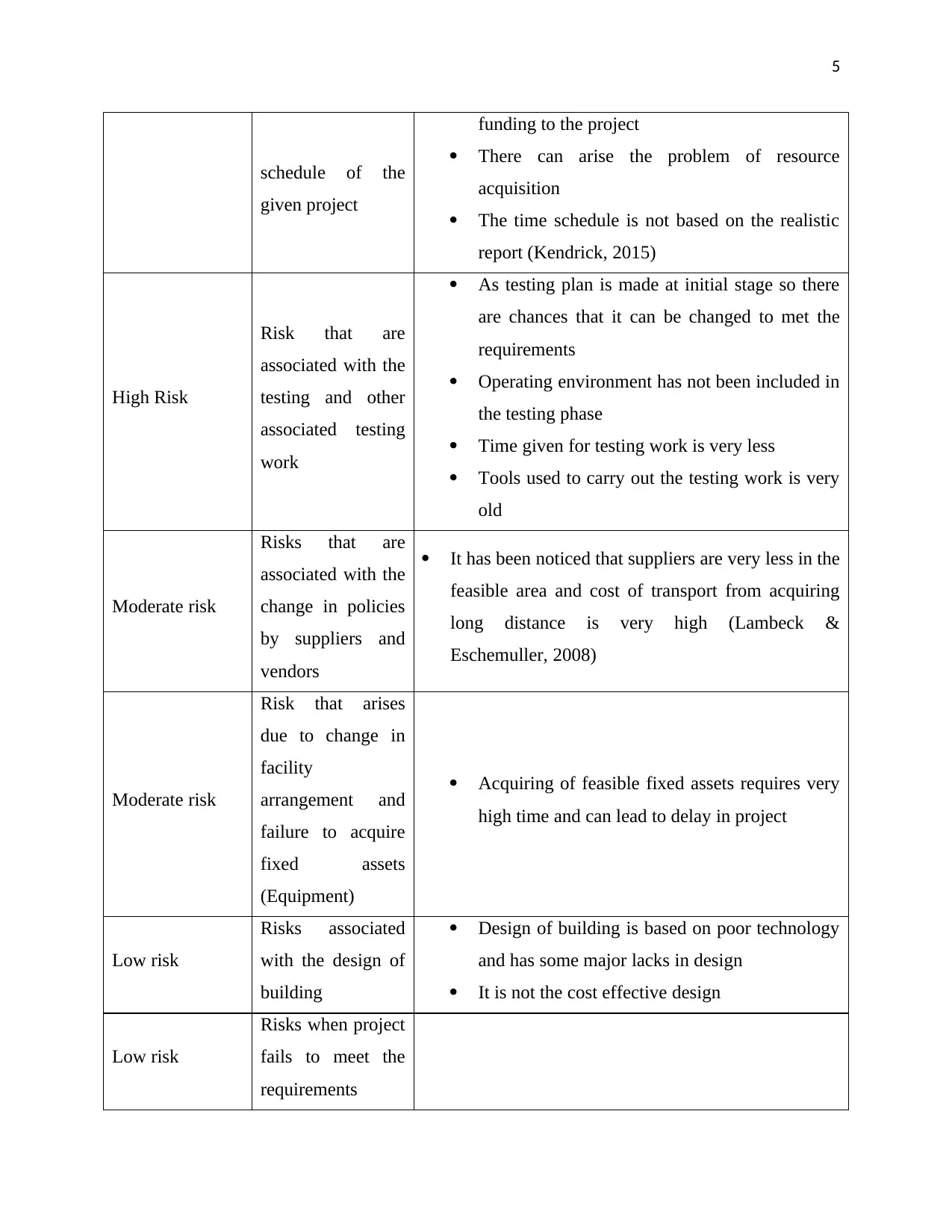
5
schedule of the
given project
funding to the project
There can arise the problem of resource
acquisition
The time schedule is not based on the realistic
report (Kendrick, 2015)
High Risk
Risk that are
associated with the
testing and other
associated testing
work
As testing plan is made at initial stage so there
are chances that it can be changed to met the
requirements
Operating environment has not been included in
the testing phase
Time given for testing work is very less
Tools used to carry out the testing work is very
old
Moderate risk
Risks that are
associated with the
change in policies
by suppliers and
vendors
It has been noticed that suppliers are very less in the
feasible area and cost of transport from acquiring
long distance is very high (Lambeck &
Eschemuller, 2008)
Moderate risk
Risk that arises
due to change in
facility
arrangement and
failure to acquire
fixed assets
(Equipment)
Acquiring of feasible fixed assets requires very
high time and can lead to delay in project
Low risk
Risks associated
with the design of
building
Design of building is based on poor technology
and has some major lacks in design
It is not the cost effective design
Low risk
Risks when project
fails to meet the
requirements
schedule of the
given project
funding to the project
There can arise the problem of resource
acquisition
The time schedule is not based on the realistic
report (Kendrick, 2015)
High Risk
Risk that are
associated with the
testing and other
associated testing
work
As testing plan is made at initial stage so there
are chances that it can be changed to met the
requirements
Operating environment has not been included in
the testing phase
Time given for testing work is very less
Tools used to carry out the testing work is very
old
Moderate risk
Risks that are
associated with the
change in policies
by suppliers and
vendors
It has been noticed that suppliers are very less in the
feasible area and cost of transport from acquiring
long distance is very high (Lambeck &
Eschemuller, 2008)
Moderate risk
Risk that arises
due to change in
facility
arrangement and
failure to acquire
fixed assets
(Equipment)
Acquiring of feasible fixed assets requires very
high time and can lead to delay in project
Low risk
Risks associated
with the design of
building
Design of building is based on poor technology
and has some major lacks in design
It is not the cost effective design
Low risk
Risks when project
fails to meet the
requirements
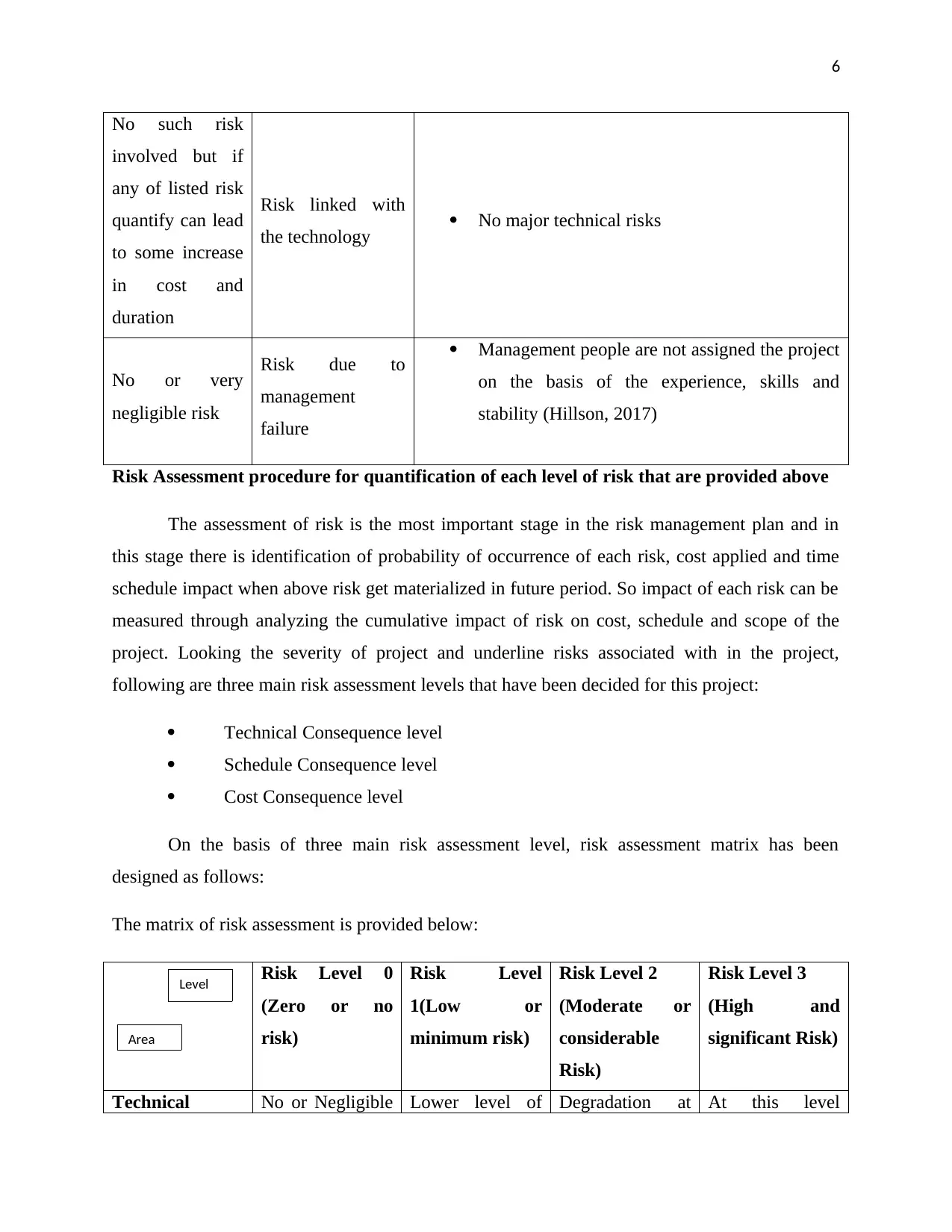
6
No such risk
involved but if
any of listed risk
quantify can lead
to some increase
in cost and
duration
Risk linked with
the technology No major technical risks
No or very
negligible risk
Risk due to
management
failure
Management people are not assigned the project
on the basis of the experience, skills and
stability (Hillson, 2017)
Risk Assessment procedure for quantification of each level of risk that are provided above
The assessment of risk is the most important stage in the risk management plan and in
this stage there is identification of probability of occurrence of each risk, cost applied and time
schedule impact when above risk get materialized in future period. So impact of each risk can be
measured through analyzing the cumulative impact of risk on cost, schedule and scope of the
project. Looking the severity of project and underline risks associated with in the project,
following are three main risk assessment levels that have been decided for this project:
Technical Consequence level
Schedule Consequence level
Cost Consequence level
On the basis of three main risk assessment level, risk assessment matrix has been
designed as follows:
The matrix of risk assessment is provided below:
Risk Level 0
(Zero or no
risk)
Risk Level
1(Low or
minimum risk)
Risk Level 2
(Moderate or
considerable
Risk)
Risk Level 3
(High and
significant Risk)
Technical No or Negligible Lower level of Degradation at At this level
Level
Area
No such risk
involved but if
any of listed risk
quantify can lead
to some increase
in cost and
duration
Risk linked with
the technology No major technical risks
No or very
negligible risk
Risk due to
management
failure
Management people are not assigned the project
on the basis of the experience, skills and
stability (Hillson, 2017)
Risk Assessment procedure for quantification of each level of risk that are provided above
The assessment of risk is the most important stage in the risk management plan and in
this stage there is identification of probability of occurrence of each risk, cost applied and time
schedule impact when above risk get materialized in future period. So impact of each risk can be
measured through analyzing the cumulative impact of risk on cost, schedule and scope of the
project. Looking the severity of project and underline risks associated with in the project,
following are three main risk assessment levels that have been decided for this project:
Technical Consequence level
Schedule Consequence level
Cost Consequence level
On the basis of three main risk assessment level, risk assessment matrix has been
designed as follows:
The matrix of risk assessment is provided below:
Risk Level 0
(Zero or no
risk)
Risk Level
1(Low or
minimum risk)
Risk Level 2
(Moderate or
considerable
Risk)
Risk Level 3
(High and
significant Risk)
Technical No or Negligible Lower level of Degradation at At this level
Level
Area
⊘ This is a preview!⊘
Do you want full access?
Subscribe today to unlock all pages.

Trusted by 1+ million students worldwide
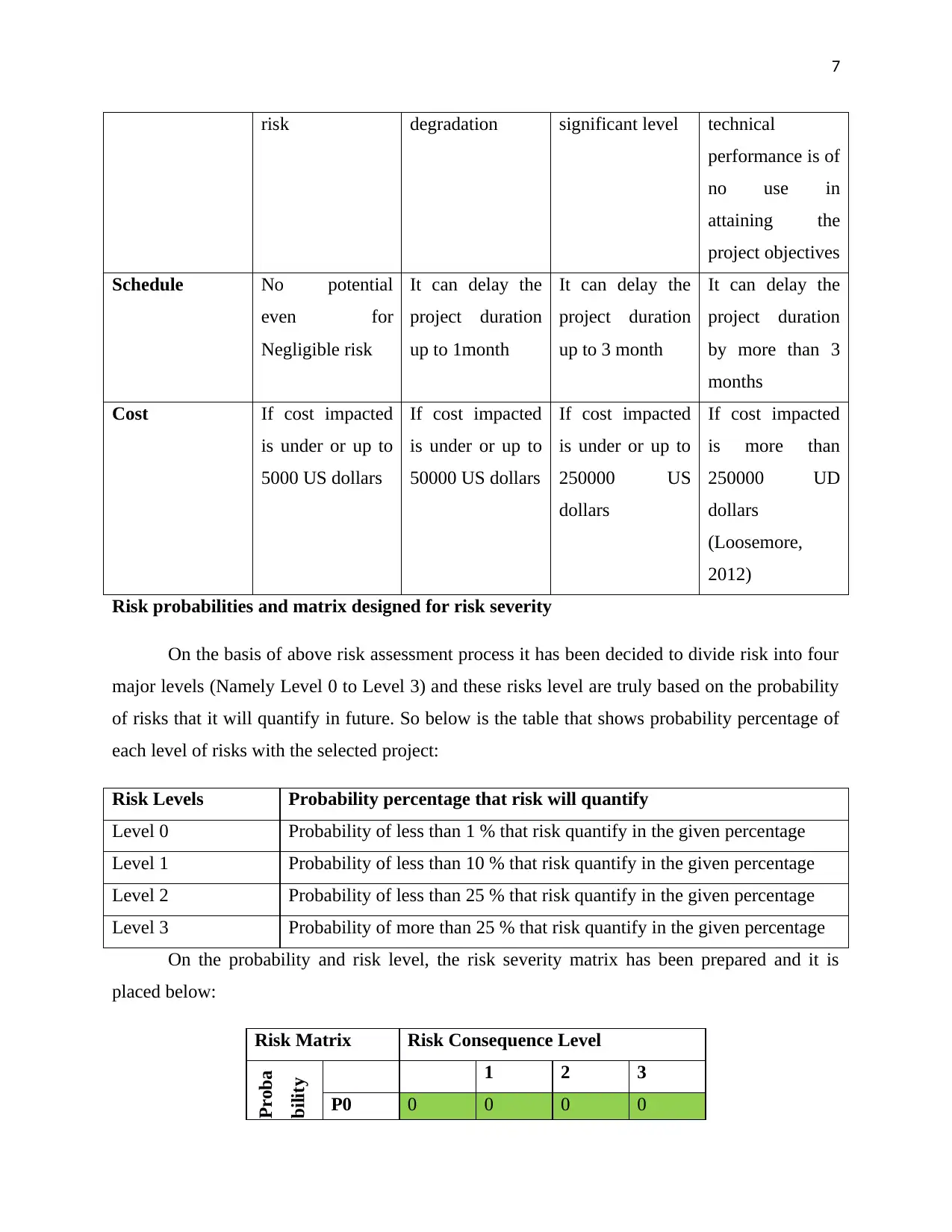
7
risk degradation significant level technical
performance is of
no use in
attaining the
project objectives
Schedule No potential
even for
Negligible risk
It can delay the
project duration
up to 1month
It can delay the
project duration
up to 3 month
It can delay the
project duration
by more than 3
months
Cost If cost impacted
is under or up to
5000 US dollars
If cost impacted
is under or up to
50000 US dollars
If cost impacted
is under or up to
250000 US
dollars
If cost impacted
is more than
250000 UD
dollars
(Loosemore,
2012)
Risk probabilities and matrix designed for risk severity
On the basis of above risk assessment process it has been decided to divide risk into four
major levels (Namely Level 0 to Level 3) and these risks level are truly based on the probability
of risks that it will quantify in future. So below is the table that shows probability percentage of
each level of risks with the selected project:
Risk Levels Probability percentage that risk will quantify
Level 0 Probability of less than 1 % that risk quantify in the given percentage
Level 1 Probability of less than 10 % that risk quantify in the given percentage
Level 2 Probability of less than 25 % that risk quantify in the given percentage
Level 3 Probability of more than 25 % that risk quantify in the given percentage
On the probability and risk level, the risk severity matrix has been prepared and it is
placed below:
Risk Matrix Risk Consequence Level
Proba
bility 1 2 3
P0 0 0 0 0
risk degradation significant level technical
performance is of
no use in
attaining the
project objectives
Schedule No potential
even for
Negligible risk
It can delay the
project duration
up to 1month
It can delay the
project duration
up to 3 month
It can delay the
project duration
by more than 3
months
Cost If cost impacted
is under or up to
5000 US dollars
If cost impacted
is under or up to
50000 US dollars
If cost impacted
is under or up to
250000 US
dollars
If cost impacted
is more than
250000 UD
dollars
(Loosemore,
2012)
Risk probabilities and matrix designed for risk severity
On the basis of above risk assessment process it has been decided to divide risk into four
major levels (Namely Level 0 to Level 3) and these risks level are truly based on the probability
of risks that it will quantify in future. So below is the table that shows probability percentage of
each level of risks with the selected project:
Risk Levels Probability percentage that risk will quantify
Level 0 Probability of less than 1 % that risk quantify in the given percentage
Level 1 Probability of less than 10 % that risk quantify in the given percentage
Level 2 Probability of less than 25 % that risk quantify in the given percentage
Level 3 Probability of more than 25 % that risk quantify in the given percentage
On the probability and risk level, the risk severity matrix has been prepared and it is
placed below:
Risk Matrix Risk Consequence Level
Proba
bility 1 2 3
P0 0 0 0 0
Paraphrase This Document
Need a fresh take? Get an instant paraphrase of this document with our AI Paraphraser
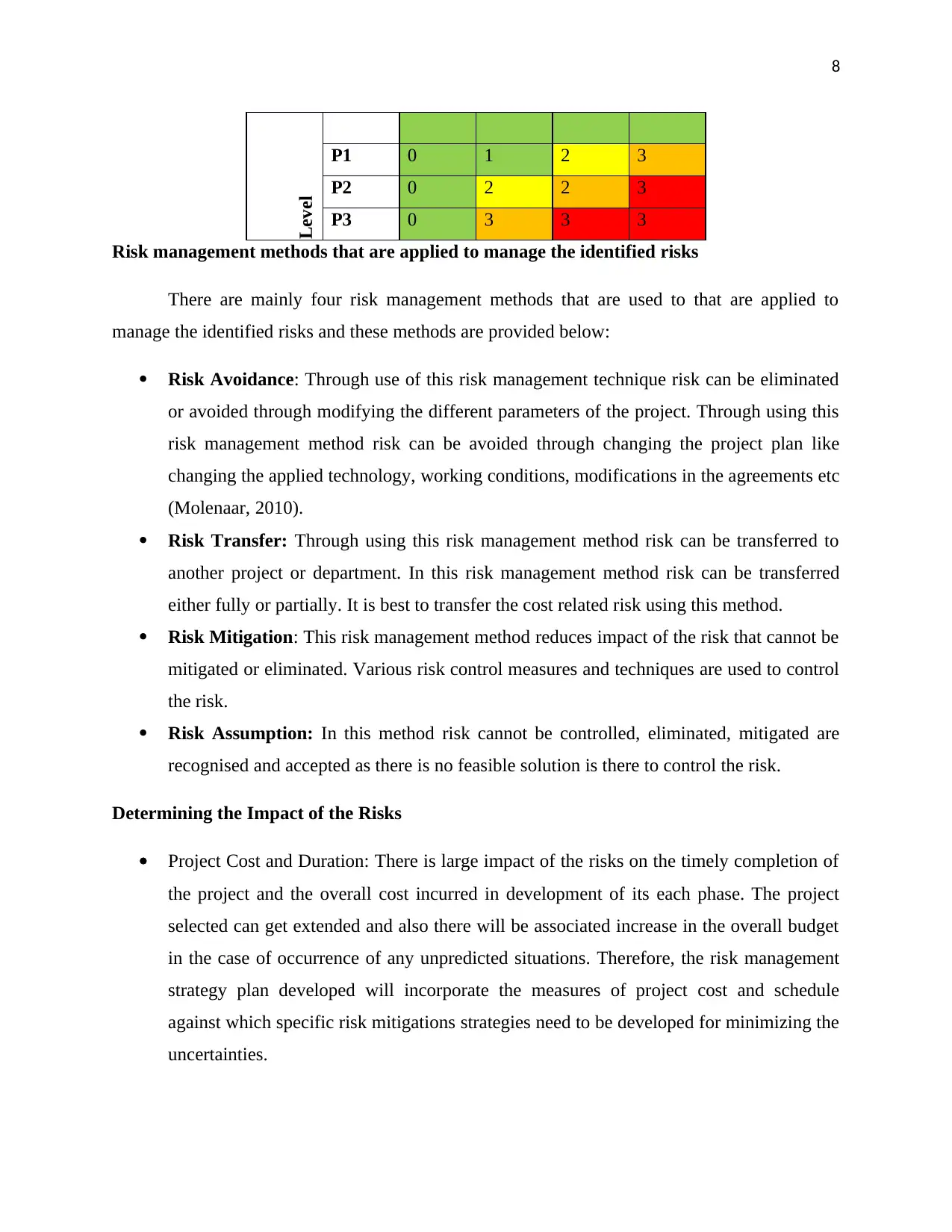
8
Level
P1 0 1 2 3
P2 0 2 2 3
P3 0 3 3 3
Risk management methods that are applied to manage the identified risks
There are mainly four risk management methods that are used to that are applied to
manage the identified risks and these methods are provided below:
Risk Avoidance: Through use of this risk management technique risk can be eliminated
or avoided through modifying the different parameters of the project. Through using this
risk management method risk can be avoided through changing the project plan like
changing the applied technology, working conditions, modifications in the agreements etc
(Molenaar, 2010).
Risk Transfer: Through using this risk management method risk can be transferred to
another project or department. In this risk management method risk can be transferred
either fully or partially. It is best to transfer the cost related risk using this method.
Risk Mitigation: This risk management method reduces impact of the risk that cannot be
mitigated or eliminated. Various risk control measures and techniques are used to control
the risk.
Risk Assumption: In this method risk cannot be controlled, eliminated, mitigated are
recognised and accepted as there is no feasible solution is there to control the risk.
Determining the Impact of the Risks
Project Cost and Duration: There is large impact of the risks on the timely completion of
the project and the overall cost incurred in development of its each phase. The project
selected can get extended and also there will be associated increase in the overall budget
in the case of occurrence of any unpredicted situations. Therefore, the risk management
strategy plan developed will incorporate the measures of project cost and schedule
against which specific risk mitigations strategies need to be developed for minimizing the
uncertainties.
Level
P1 0 1 2 3
P2 0 2 2 3
P3 0 3 3 3
Risk management methods that are applied to manage the identified risks
There are mainly four risk management methods that are used to that are applied to
manage the identified risks and these methods are provided below:
Risk Avoidance: Through use of this risk management technique risk can be eliminated
or avoided through modifying the different parameters of the project. Through using this
risk management method risk can be avoided through changing the project plan like
changing the applied technology, working conditions, modifications in the agreements etc
(Molenaar, 2010).
Risk Transfer: Through using this risk management method risk can be transferred to
another project or department. In this risk management method risk can be transferred
either fully or partially. It is best to transfer the cost related risk using this method.
Risk Mitigation: This risk management method reduces impact of the risk that cannot be
mitigated or eliminated. Various risk control measures and techniques are used to control
the risk.
Risk Assumption: In this method risk cannot be controlled, eliminated, mitigated are
recognised and accepted as there is no feasible solution is there to control the risk.
Determining the Impact of the Risks
Project Cost and Duration: There is large impact of the risks on the timely completion of
the project and the overall cost incurred in development of its each phase. The project
selected can get extended and also there will be associated increase in the overall budget
in the case of occurrence of any unpredicted situations. Therefore, the risk management
strategy plan developed will incorporate the measures of project cost and schedule
against which specific risk mitigations strategies need to be developed for minimizing the
uncertainties.
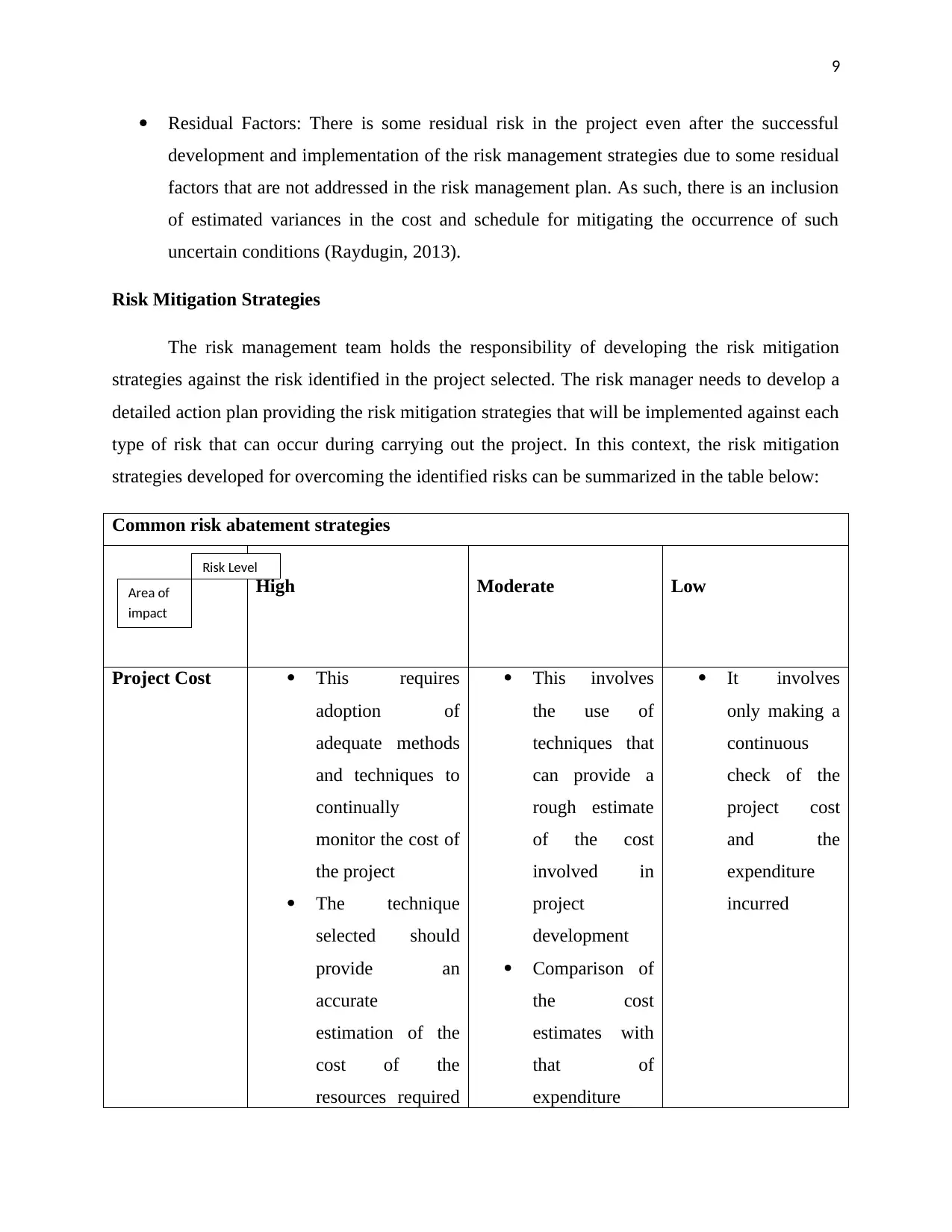
9
Residual Factors: There is some residual risk in the project even after the successful
development and implementation of the risk management strategies due to some residual
factors that are not addressed in the risk management plan. As such, there is an inclusion
of estimated variances in the cost and schedule for mitigating the occurrence of such
uncertain conditions (Raydugin, 2013).
Risk Mitigation Strategies
The risk management team holds the responsibility of developing the risk mitigation
strategies against the risk identified in the project selected. The risk manager needs to develop a
detailed action plan providing the risk mitigation strategies that will be implemented against each
type of risk that can occur during carrying out the project. In this context, the risk mitigation
strategies developed for overcoming the identified risks can be summarized in the table below:
Common risk abatement strategies
High Moderate Low
Project Cost This requires
adoption of
adequate methods
and techniques to
continually
monitor the cost of
the project
The technique
selected should
provide an
accurate
estimation of the
cost of the
resources required
This involves
the use of
techniques that
can provide a
rough estimate
of the cost
involved in
project
development
Comparison of
the cost
estimates with
that of
expenditure
It involves
only making a
continuous
check of the
project cost
and the
expenditure
incurred
Risk Level
Area of
impact
Residual Factors: There is some residual risk in the project even after the successful
development and implementation of the risk management strategies due to some residual
factors that are not addressed in the risk management plan. As such, there is an inclusion
of estimated variances in the cost and schedule for mitigating the occurrence of such
uncertain conditions (Raydugin, 2013).
Risk Mitigation Strategies
The risk management team holds the responsibility of developing the risk mitigation
strategies against the risk identified in the project selected. The risk manager needs to develop a
detailed action plan providing the risk mitigation strategies that will be implemented against each
type of risk that can occur during carrying out the project. In this context, the risk mitigation
strategies developed for overcoming the identified risks can be summarized in the table below:
Common risk abatement strategies
High Moderate Low
Project Cost This requires
adoption of
adequate methods
and techniques to
continually
monitor the cost of
the project
The technique
selected should
provide an
accurate
estimation of the
cost of the
resources required
This involves
the use of
techniques that
can provide a
rough estimate
of the cost
involved in
project
development
Comparison of
the cost
estimates with
that of
expenditure
It involves
only making a
continuous
check of the
project cost
and the
expenditure
incurred
Risk Level
Area of
impact
⊘ This is a preview!⊘
Do you want full access?
Subscribe today to unlock all pages.

Trusted by 1+ million students worldwide
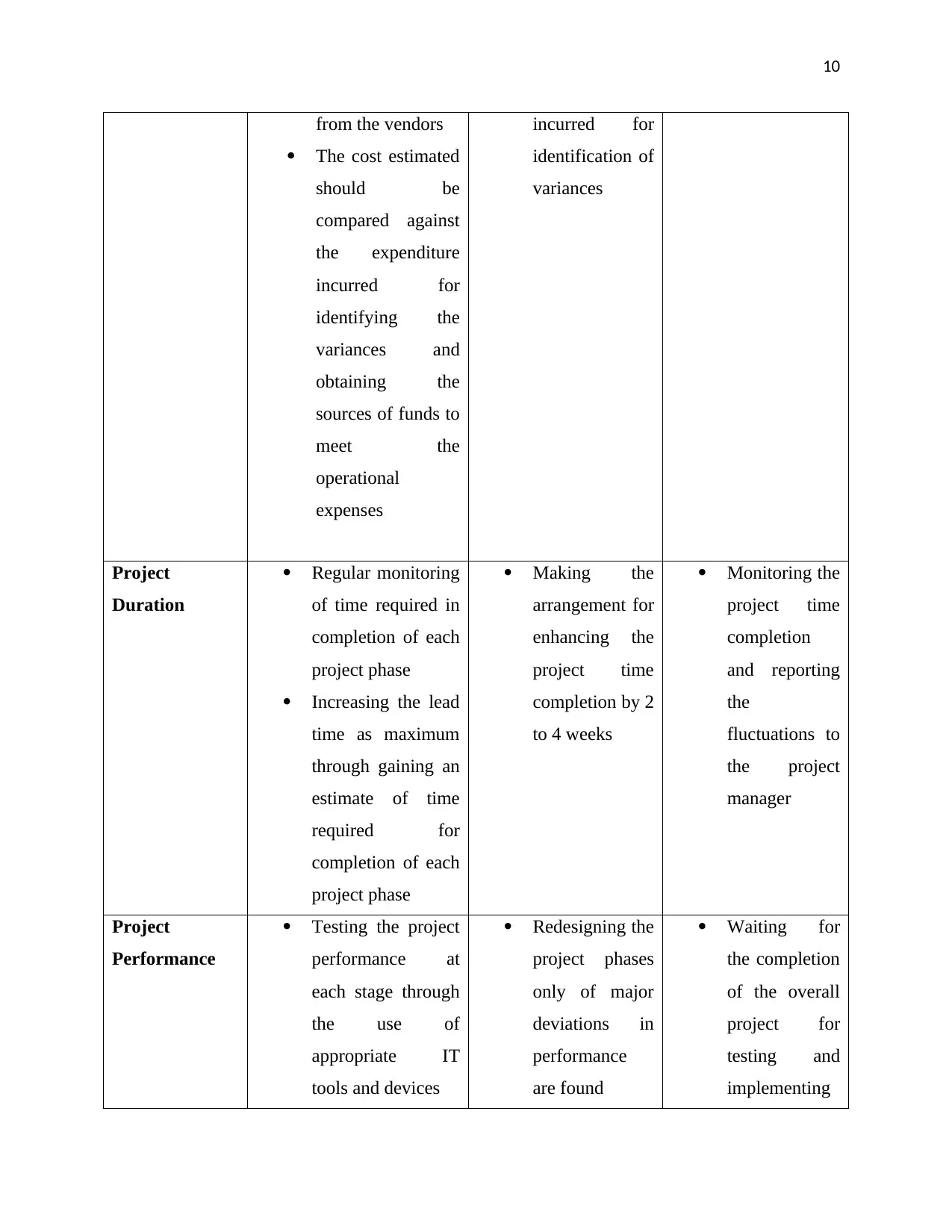
10
from the vendors
The cost estimated
should be
compared against
the expenditure
incurred for
identifying the
variances and
obtaining the
sources of funds to
meet the
operational
expenses
incurred for
identification of
variances
Project
Duration
Regular monitoring
of time required in
completion of each
project phase
Increasing the lead
time as maximum
through gaining an
estimate of time
required for
completion of each
project phase
Making the
arrangement for
enhancing the
project time
completion by 2
to 4 weeks
Monitoring the
project time
completion
and reporting
the
fluctuations to
the project
manager
Project
Performance
Testing the project
performance at
each stage through
the use of
appropriate IT
tools and devices
Redesigning the
project phases
only of major
deviations in
performance
are found
Waiting for
the completion
of the overall
project for
testing and
implementing
from the vendors
The cost estimated
should be
compared against
the expenditure
incurred for
identifying the
variances and
obtaining the
sources of funds to
meet the
operational
expenses
incurred for
identification of
variances
Project
Duration
Regular monitoring
of time required in
completion of each
project phase
Increasing the lead
time as maximum
through gaining an
estimate of time
required for
completion of each
project phase
Making the
arrangement for
enhancing the
project time
completion by 2
to 4 weeks
Monitoring the
project time
completion
and reporting
the
fluctuations to
the project
manager
Project
Performance
Testing the project
performance at
each stage through
the use of
appropriate IT
tools and devices
Redesigning the
project phases
only of major
deviations in
performance
are found
Waiting for
the completion
of the overall
project for
testing and
implementing
Paraphrase This Document
Need a fresh take? Get an instant paraphrase of this document with our AI Paraphraser
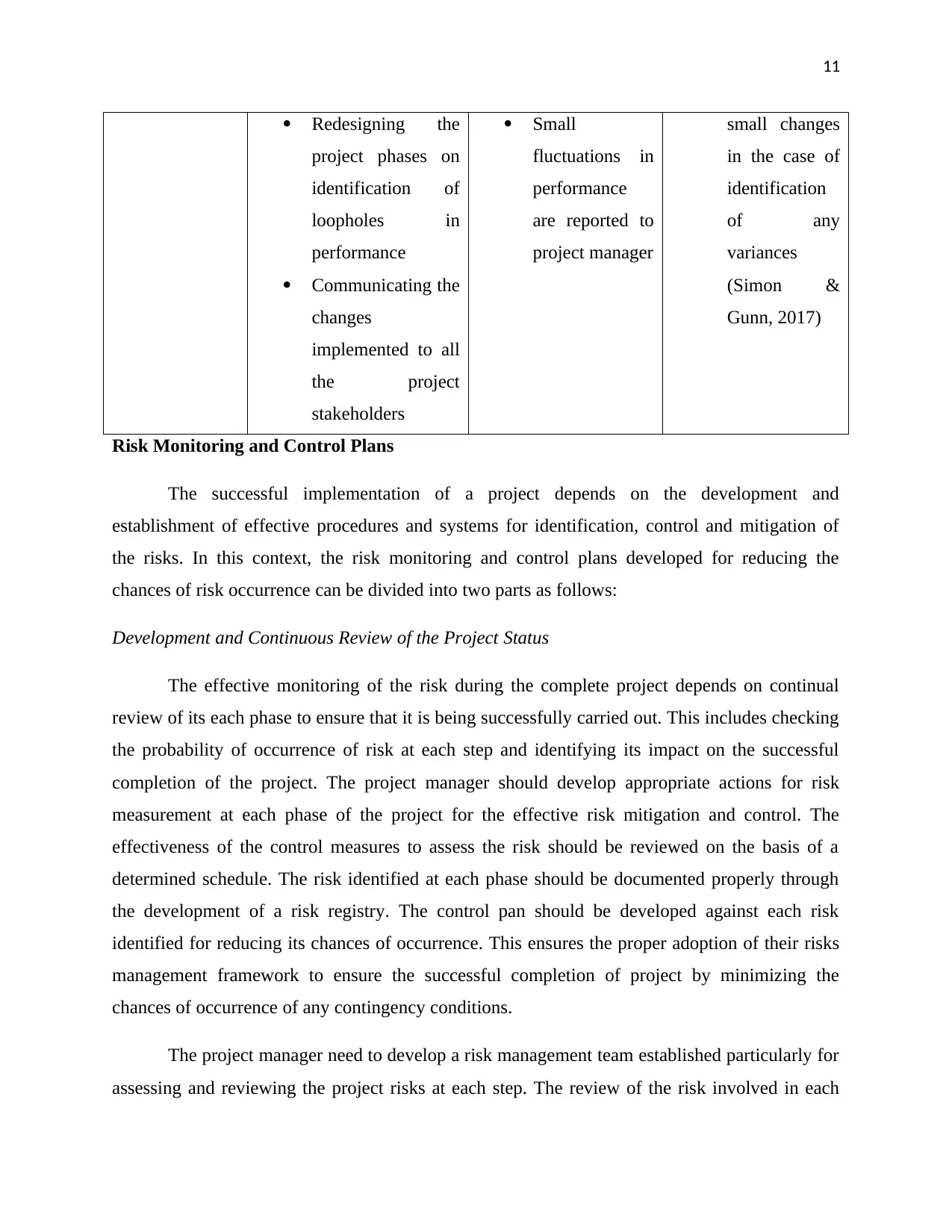
11
Redesigning the
project phases on
identification of
loopholes in
performance
Communicating the
changes
implemented to all
the project
stakeholders
Small
fluctuations in
performance
are reported to
project manager
small changes
in the case of
identification
of any
variances
(Simon &
Gunn, 2017)
Risk Monitoring and Control Plans
The successful implementation of a project depends on the development and
establishment of effective procedures and systems for identification, control and mitigation of
the risks. In this context, the risk monitoring and control plans developed for reducing the
chances of risk occurrence can be divided into two parts as follows:
Development and Continuous Review of the Project Status
The effective monitoring of the risk during the complete project depends on continual
review of its each phase to ensure that it is being successfully carried out. This includes checking
the probability of occurrence of risk at each step and identifying its impact on the successful
completion of the project. The project manager should develop appropriate actions for risk
measurement at each phase of the project for the effective risk mitigation and control. The
effectiveness of the control measures to assess the risk should be reviewed on the basis of a
determined schedule. The risk identified at each phase should be documented properly through
the development of a risk registry. The control pan should be developed against each risk
identified for reducing its chances of occurrence. This ensures the proper adoption of their risks
management framework to ensure the successful completion of project by minimizing the
chances of occurrence of any contingency conditions.
The project manager need to develop a risk management team established particularly for
assessing and reviewing the project risks at each step. The review of the risk involved in each
Redesigning the
project phases on
identification of
loopholes in
performance
Communicating the
changes
implemented to all
the project
stakeholders
Small
fluctuations in
performance
are reported to
project manager
small changes
in the case of
identification
of any
variances
(Simon &
Gunn, 2017)
Risk Monitoring and Control Plans
The successful implementation of a project depends on the development and
establishment of effective procedures and systems for identification, control and mitigation of
the risks. In this context, the risk monitoring and control plans developed for reducing the
chances of risk occurrence can be divided into two parts as follows:
Development and Continuous Review of the Project Status
The effective monitoring of the risk during the complete project depends on continual
review of its each phase to ensure that it is being successfully carried out. This includes checking
the probability of occurrence of risk at each step and identifying its impact on the successful
completion of the project. The project manager should develop appropriate actions for risk
measurement at each phase of the project for the effective risk mitigation and control. The
effectiveness of the control measures to assess the risk should be reviewed on the basis of a
determined schedule. The risk identified at each phase should be documented properly through
the development of a risk registry. The control pan should be developed against each risk
identified for reducing its chances of occurrence. This ensures the proper adoption of their risks
management framework to ensure the successful completion of project by minimizing the
chances of occurrence of any contingency conditions.
The project manager need to develop a risk management team established particularly for
assessing and reviewing the project risks at each step. The review of the risk involved in each
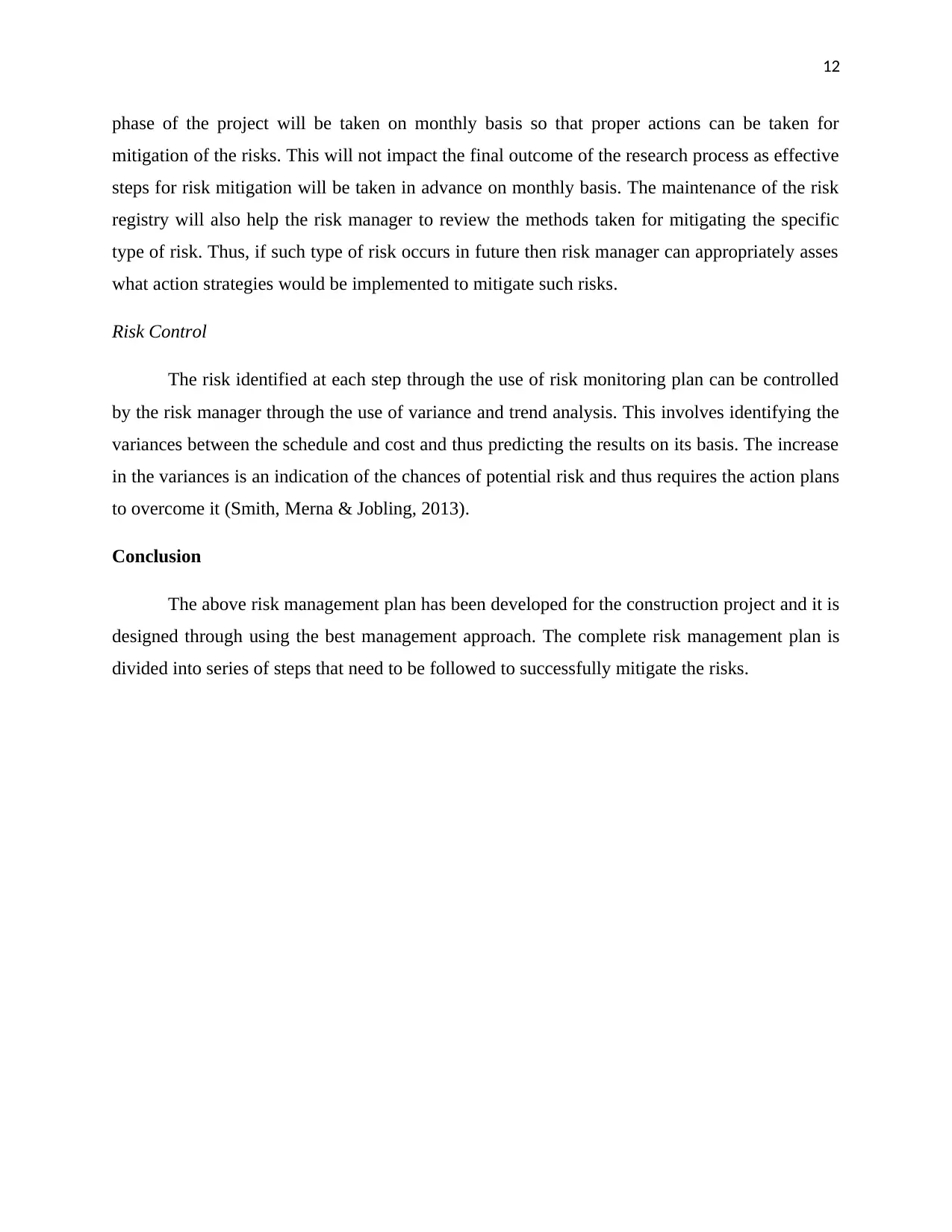
12
phase of the project will be taken on monthly basis so that proper actions can be taken for
mitigation of the risks. This will not impact the final outcome of the research process as effective
steps for risk mitigation will be taken in advance on monthly basis. The maintenance of the risk
registry will also help the risk manager to review the methods taken for mitigating the specific
type of risk. Thus, if such type of risk occurs in future then risk manager can appropriately asses
what action strategies would be implemented to mitigate such risks.
Risk Control
The risk identified at each step through the use of risk monitoring plan can be controlled
by the risk manager through the use of variance and trend analysis. This involves identifying the
variances between the schedule and cost and thus predicting the results on its basis. The increase
in the variances is an indication of the chances of potential risk and thus requires the action plans
to overcome it (Smith, Merna & Jobling, 2013).
Conclusion
The above risk management plan has been developed for the construction project and it is
designed through using the best management approach. The complete risk management plan is
divided into series of steps that need to be followed to successfully mitigate the risks.
phase of the project will be taken on monthly basis so that proper actions can be taken for
mitigation of the risks. This will not impact the final outcome of the research process as effective
steps for risk mitigation will be taken in advance on monthly basis. The maintenance of the risk
registry will also help the risk manager to review the methods taken for mitigating the specific
type of risk. Thus, if such type of risk occurs in future then risk manager can appropriately asses
what action strategies would be implemented to mitigate such risks.
Risk Control
The risk identified at each step through the use of risk monitoring plan can be controlled
by the risk manager through the use of variance and trend analysis. This involves identifying the
variances between the schedule and cost and thus predicting the results on its basis. The increase
in the variances is an indication of the chances of potential risk and thus requires the action plans
to overcome it (Smith, Merna & Jobling, 2013).
Conclusion
The above risk management plan has been developed for the construction project and it is
designed through using the best management approach. The complete risk management plan is
divided into series of steps that need to be followed to successfully mitigate the risks.
⊘ This is a preview!⊘
Do you want full access?
Subscribe today to unlock all pages.

Trusted by 1+ million students worldwide
1 out of 13
Related Documents
Your All-in-One AI-Powered Toolkit for Academic Success.
+13062052269
info@desklib.com
Available 24*7 on WhatsApp / Email
![[object Object]](/_next/static/media/star-bottom.7253800d.svg)
Unlock your academic potential
Copyright © 2020–2025 A2Z Services. All Rights Reserved. Developed and managed by ZUCOL.





